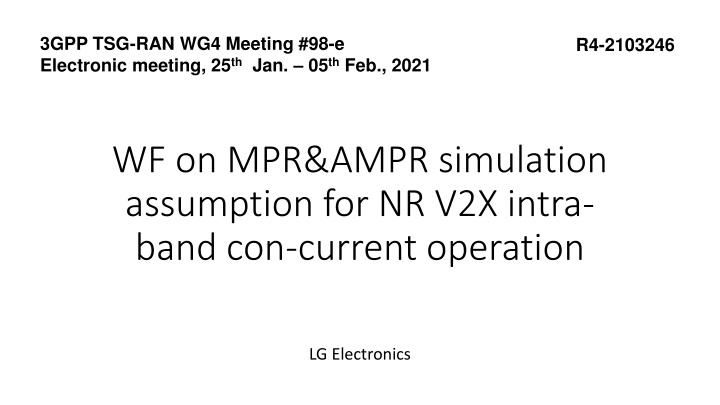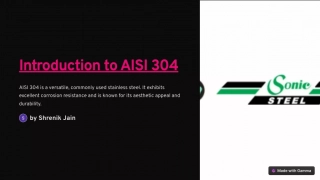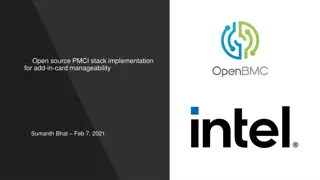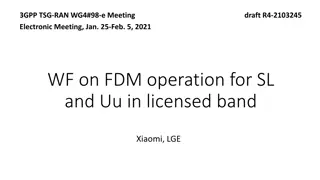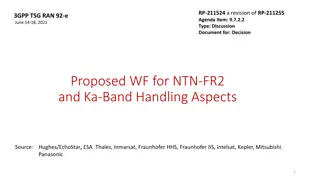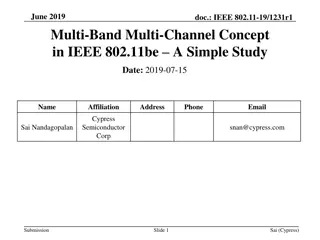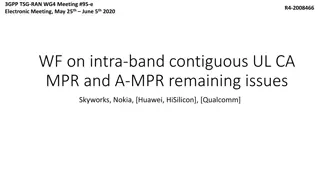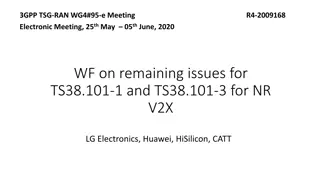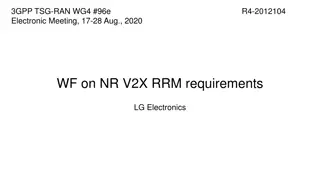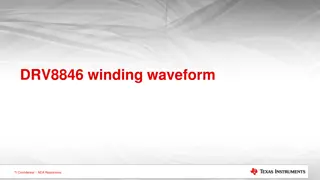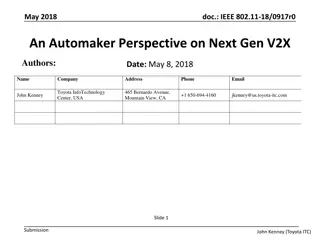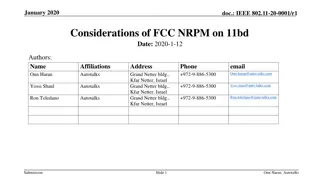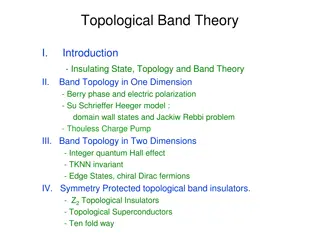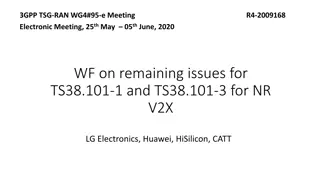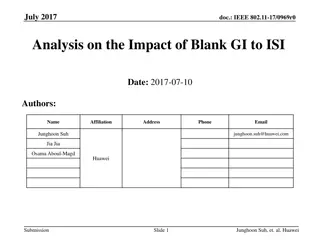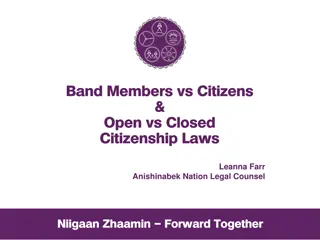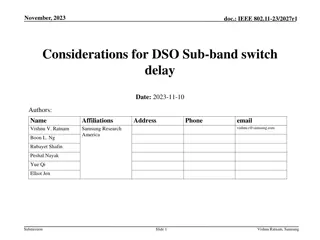Overview of RF Architecture and Waveform Assumptions for NR V2X Intra-Band Operation
In the electronic meeting of 3GPP TSG-RAN-WG4, discussions were held on the RF architecture and waveform assumptions for NR V2X intra-band operation in band n79. Various options and recommendations were presented regarding RF architecture, antenna architecture, and waveform definitions for efficient simultaneous transmission and reception operations. The focus was on deriving MPR/A-MPR requirements, defining PSSCH/PSCCH transmissions, evaluating channel bandwidth configurations, and considering different waveform options for NR UEs. The meeting emphasized the need for further discussions on specific operational scenarios to optimize NR V2X operations.
Download Presentation

Please find below an Image/Link to download the presentation.
The content on the website is provided AS IS for your information and personal use only. It may not be sold, licensed, or shared on other websites without obtaining consent from the author.If you encounter any issues during the download, it is possible that the publisher has removed the file from their server.
You are allowed to download the files provided on this website for personal or commercial use, subject to the condition that they are used lawfully. All files are the property of their respective owners.
The content on the website is provided AS IS for your information and personal use only. It may not be sold, licensed, or shared on other websites without obtaining consent from the author.
E N D
Presentation Transcript
3GPP TSG-RAN WG4 Meeting #98-e Electronic meeting, 25thJan. 05thFeb., 2021 R4-2103246 WF on MPR&R simulation assumption for NR V2X intra- band con-current operation LG Electronics
Background on architecture Issue 1-3-1: Whether the RF architecture of 2UL intra-band CA could apply to V2X intra- band con-current operation in band n79 Tentative agreements: Option 2: No. The RF architecture of 2UL intra-band CA could not simply apply to V2X intra-band con-current operation in band n79 Recommendations for 2nd round: The initial consideration on RF architecture for TDM operation and FDM operation can be discussed in the 2nd round based on the corresponding WF if possible Issue 1-3-3: Shared antenna architecture or separate antenna architecture Tentative agreements: None. Candidate options: Option 2: Separate antenna architecture. Option 3: Decision of shared or separate antenna architecture should be left to UE vendors. Recommendations for 2nd round: Make final decision between option 2 and option 3 in the 2nd round. 1stround discussion results for RF architecture Separate RF architecture : LGE, Xiaomi, CATT, Huawei, Hi silicon UE implementation (both shared & separate RF architecture) : Qualcomm, vivo, Ericsson
WF on Scope To derive MPR/A-MPR requirements for NR V2X intra-band con-current operation in a licensed band, the baseline RF architecture is separate RF architecture to support different waveform and individual power control for both NR Uu and NR SL operation. [Qualcomm] both the shared and separate RF architectures will be considered RAN4 do not preclude other RF architecture, but some operation will be restricted. The basic simulation assumptions for intra-band con-current operation in a licensed band can reuse the simulation assumptions in TR38.886 in Rel-16. The example operating NR V2X band is n79. Firstly, RAN4 can specify the intra-band contiguous con-current operation with adjacent channel. In here, do not allow simultaneous NR UL Transmission and NR SL reception within adjacent channel. Target is CA bandwidth class B (2CCs, 20 MHz aggregated BW 100 MHz) for NR V2X intra- band contiguous con-current operation. For the intra-band non-contiguous con-current operation, RAN4 need further discussion to allow FDM operation and study the frequency gap between NR SL CC and NR Uu CC.
WF on allocations and waveforms Define each PSSCH/PSCCH transmission, simultaneous multiple PSFCH transmission and S-SSB transmission for PC3 NR V2X intra-band con-current operation Inner/outer contiguous allocations definition for PC3 is used to evaluate MPR Focus on only CP-OFDM waveform in NR SL UE is used. For NR UE, both CP-OFDM and DFT-S-OFDM waveforms are considered. To derive A-MPR requirements, RAN4 applied the current/future additional SEM and additional SE according to regional regulation requirements. NS_33 for current ETSI regulation NS_52 for current FCC regulation NS_xx for future ETSI regulation Channel BW configurations for class B should be evaluated Class B: RAN4 evaluate following CBW combinations At least 10MHz (NR SL, 30kHz SCS)+10MHz (NR Uu, 30kHz SCS) 10MHz (NR SL, 30kHz SCS) +20/40/60/80MHz (NR Uu, 30kHz SCS) 20MHz (NR SL, 30kHz SCS) + 20/40/80MHz (NR Uu, 30kHz SCS) Other CBW combinations are not precluded
WF on assumptions for MPR A-MPR evaluation parameter center frequency Assumption 4.5GHz (n79) 10/20/30/40MHz for NR SL 10/20/40/60/80MHz for NR Uu 23dBm 15KHz, 30kHz and 60kHz Each Bandwidth Maximum total output power numerology Modulation QPSK/16QAM/64QAM/256QAM CP-OFDM for NR SL CP-OFDM or DFT-S-OFDM for NR Uu 25dBc 25dBc 45~60dBc PA calibrated per CC to deliver - 30dBc ACLR for a fully allocated RBs in 20MHz QPSK DFT-S-OFDM waveform at 1dB MPR. Waveform Carrier leakage IQ image CIM3 PA calibration
WF on assumptions for MPR A-MPR evaluation Items Assumption Support {10, 12, 15, 20, 25, 50, 75, 100} PRBs for NR SL. No restriction of size of RB for NR Uu. Allowed sub-channel sizes for NR SL 10,12,15,20, 24, 25,30,36, 40,45,48,50,60,70,72, 75,80,84, 90,96,100,105,108,110,120,130,132,135, 140,144,150,156,160,165,168,170,175,18 0,190,192,195,200,204,210, 216. No restriction of LCRB for NR Uu. Allowed LCRB allocation for NR SL Regarding PSCCH / PSSCH multiplexing for NR SL PSCCH size for NR SL 10RB*3 Symbols PSD offset of X dB between PSCCH and PSSCH for NR SL 0dB * If there is not indicate the detail parameters, then follow TR38.886 for NR SL operation. Also follow TS38.211/TS38.212/TS38.101-1 for NR Uu operation
References 1. R4-2102991, Email discussion summary for [98e][143] NRSL_enh_Part_2, CATT, 3GPP TSG-RAN WG4 #98-e 2. R4-2100283, Consideration on partial usage operation with PC5 and Uu in a licensed band, LGE, 3GPP TSG-RAN WG4 #98-e 3. R4-2101877, Synchronous operation between NR Uu and NR SL in an operating band, Xiaomi, 3GPP TSG-RAN WG4 #98-e
